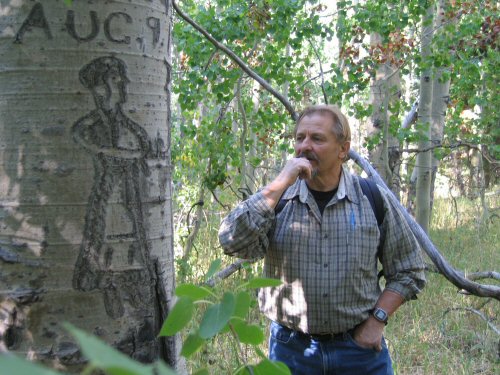People, particularly boys and young men, have an almost uncontrollable impulse to leave their mark on their surroundings. Whether the graffiti that decorates the hearts of large cities or the now-preserved etchings of Spanish conquistadors on the rocks of El Morro, we have to show others we’ve already been there. The same is true of the lonely Basque men who wandered the back country of the American West with their flocks of sheep, though their canvas was the aspen trees that dotted the landscape.

- Basque arborglyphs, as carvings in trees are called, have been found all over the western United States, stretching north-south from Washington state to Texas and east-west from North Dakota to California. Wherever Basque shepherds found themselves in groves of aspens, they made their mark on the soft bark of the trees.
- No one has done more to study these arborglyphs than Joxe Mallea-Olaetxe, a former professor at the University of Nevada, Reno. Joxe has written extensively about the arborglyphs, most prominently in his book Speaking Through the Aspens.
- The carvings span topics and themes from simply recording names to renderings of people (including female forms in various states of undress) and animals to ruminations on life. Often, they complained about the work and loneliness: Joxe and his colleagues have found carvings saying that the camp tender was a “lazy donkey with a sombrero,” “Sheep, you are killing me,” and “If [sheepherder] life is what these damn oldtimers told me it was, my balls are carnations.”
- The trees also served as a way to communicate. Herders would carve messages that others would follow up on. For example, on one tree, one herder wrote “Wine and women both are good.” Several years later, another responded “Yes, but they are hard on your pocket.”
- Of course, carving into trees isn’t a uniquely Basque activity. Irish sheepherders also made their marks on the aspens and everyone is familiar with the lovers who carve their initials onto trees. However, tree carvings go back much further. Both Native Americans and the Maori carved onto the surfaces of trees, marking astronomical events or recording their ancestry.
Primary source: Carving Out History: The Basque Aspens by Joxe Mallea-Olaetxe, in Forest History Today, Spring/Fall 2001.
Discover more from Buber's Basque Page
Subscribe to get the latest posts sent to your email.


One thought on “Basque Fact of the Week: Tree Carvings of the Sheepherders”